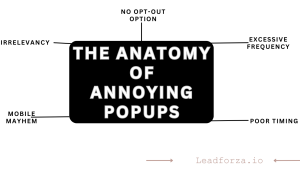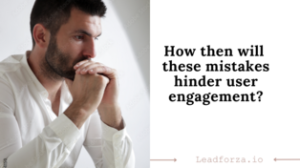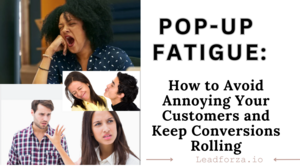The truth is you may have been seeing popups but you didn’t just realize that they were called popups.
Let’s say for instance, you are browsing a website and a little surprise window pops up on your screen. Those are called popups.
They appear on a website and often contain promotional messages, limited-time offers, free ebooks, or subscription prompts. They serve various purposes and offer benefits for businesses.
READ ALSO – Beyond Discounts: 5 Creative Popup Incentives That Will Drive Sales Without Price Slashing
Firstly, popups can grab visitors’ attention, increasing the likelihood of engagement with the displayed content.
They are effective for promoting discounts, special offers, or new products, encouraging conversions and sales. They can also offer helpful tips or point you towards what you’re looking for, improving your user experience.
Additionally, popups can help businesses build their email subscriber lists by prompting visitors to sign up for newsletters or updates.
This enables companies to maintain communication with potential customers and nurture leads over time.
Popups also aid in reducing bounce rates by keeping users engaged with relevant information.
However, excessive popups can lead to what is known as popup fatigue.
READ ALSO
- The Secret Tool to Sell More Custom T-shirts on Your Ecommerce Websites
- Beyond Discounts: 5 Creative Popup Incentives That Will Drive Sales Without Price Slashing
- Personalization Paradox: Striking the Balance Between Relevancy and Creepiness in Popups
- Gamification Power: How Interactive Popups Can Boost Engagement and Sales
- Pop-Up Psychology: 7 Underrated Strategies to Skyrocket Conversions in 2024
- Beyond Exit Intent: 5 Advanced Popup Triggers Ecommerce Stores are Missing out on
- Popups for Customer Education and Support: Providing Valuable Resources
Popup Fatigue

When users encounter an overwhelming number of popups, it can lead to irritation and frustration, diminishing the overall enjoyment of the website.
This fatigue adversely affects user engagement and conversions as it creates a negative perception of the brand or website.
Users may become hesitant to explore further or may leave the site altogether, impacting bounce rates.
Excessive popups can also distract users from the main content, disrupting their browsing experience.
Moreover, users might develop a habit of dismissing popups without paying attention to their content, resulting in missed opportunities for businesses to convey important messages or promotions.
Think of it like friendly waiters; too much nagging makes the customers want to leave the restaurant.
What then can e-commerce owners do?
E-commerce owners must use popups strategically to avoid annoying customers. They should offer users something truly valuable, and watch their conversions rise, not flee!
By employing popups wisely, businesses can effectively convey relevant information or promotions without disrupting the user’s browsing journey.
Timing is key; popups should appear at opportune moments, such as when a user is about to exit or has spent a considerable time on the site.
Also, tailoring the content of popups to match user interests and behavior enhances their relevance, making them more likely to be well-received.
Furthermore, Implementing user-friendly features, such as easy-to-locate close buttons and an option to dismiss popups, demonstrates respect for the user’s preferences.
It must be noted that striking a balance in frequency is very essential; avoiding excessive popups prevents overwhelming visitors on your site.
The Anatomy of Annoying Popups

We will now consider common popup mistakes that e-commerce owners make which contributes to fatigue.
- Excessive Frequency: This when popups appear too frequently and disrupt the user experience.
- Poor Timing: Intrusive popups that interrupt a user immediately upon entering a site can be irritating.
- Irrelevance: Lack of relevance is also a key issue. When e-commerce owners display irrelevant content or promotions that don’t align with user interests, it can lead to disengagement.
- Mobile Mayhem: Overly complex designs or hard-to-find close buttons can frustrate users. Tiny buttons, unresponsive layouts, and text overflowing the screen all contribute to rage-clicks and lost conversions. Also, popups that don’t adapt to different devices can be disruptive and negatively impact the user experience.
- No Opt-out Option: Not providing an option to easily opt-out or dismiss popups can contribute to fatigue, as users appreciate having control over their browsing experience.
To explore different triggers for popup appearance, CLICK HERE.
How then will these mistakes hinder user engagement?

Below are ways through which popup mistakes can frustrate the user and hinder user engagement.
- Excessive popups, appearing too frequently or immediately upon entry, irritate users and divert attention from the main content.
- Popups that are wrongly timed can interrupt tasks, leading to annoyance and a negative perception of the brand.
- Irrelevant popups that display unimportant content or promotions, may make users feel bombarded and lose interest.
- Complicated designs or hard-to-find close buttons contribute to frustration, making it challenging for users to interact with popups seamlessly.
- Additionally, non-responsive popups on mobile devices can hinder accessibility, diminishing the user experience.
- The absence of opt-out options or dismiss buttons deprives users of control, amplifying frustration.
Strategies for Combating Popup Fatigue
E-commerce owners should pay attention to this! The most productive strategies for combating popup fatigue include the following:
- Targeting and Triggering
- Content and Design
- Frequency and Control
- Advanced Techniques for Conversion-Boosting Popups
Targeting and Triggering
E-commerce owners must know the importance of showing popups to the right users at the right time and practicalize it.
Wrong timing is like blasting your grandma who loves crocheting with news of cryptocurrency instead of crocheting pattens.To remedy that, you can show her yarn deals when she browses for craft supplies.
Timely and targeted popups enhance relevance, presenting users with content or offers that align with their interests and behaviors.
This specificity of this method increases the likelihood of users finding the information valuable, leading to higher engagement and conversions.
By understanding user preferences and behavior, businesses can tailor popups to specific segments, delivering personalized messages that resonate.
Moreover, displaying popups at opportune moments, such as when users are about to exit or have completed a meaningful interaction, ensures that the message is more likely to capture their attention.
What effective targeting options are available to the E-commerce owner?
To start with, they must understand user behavior to enable their businesses to deliver relevant popups based on actions such as clicks, time spent on the site, or previous interactions.
Then, they must target users with specific behaviors and ensure that the popups resonate with their interests, increasing the chances of engagement.
They can also consider site location targeting. This involves displaying popups based on the geographical location of the user, allowing businesses to customize messages according to regional preferences or events.
Finally, E-commerce owners should practice page content targeting. This tailors popups to specific pages or content categories, delivering messages that align with what users are currently viewing.
Content and Design
When it comes to content and design, e-commerce owners can follow the follow steps to skyrocket conversions:
- Advocate for clear, concise, and valuable content in popups.
- Recommend strong calls to action that resonate with the user’s intent.
- Promote visually appealing and unobtrusive popup designs.
- Encourage mobile-friendly popups that adapt to smaller screens.
Frequency and Control
Popup frequency sweet spots refer to the optimal balance in displaying popups that neither overwhelms nor neglects users.
They determine sweet spots which involve understanding the preferences of the target audience and considering industry standards.
For some audiences, infrequent and well-timed popups may be more effective to prevent irritation and fatigue.
In contrast, certain industries or user segments may tolerate a higher frequency of popups, especially if the content is highly relevant and valuable.
It is of utmost importance to strike a balance that aligns with user expectations and avoids annoyance, ensuring that popups contribute positively to engagement and conversions.
E-commerce owners should also consider opt-out options and popup management tools. The benefits of the aforementioned tools include:
Firstly, it respects users’ autonomy, allowing them to control their browsing experience and opt-out of receiving popups if they find them intrusive.
This helps prevent frustration and contributes to a positive user perception of the website or brand.
Additionally, opt-out options can reduce popup fatigue, as users appreciate the flexibility to engage with content at their own pace.
Popup management tools enable users to customize their preferences, deciding the type and frequency of popups they wish to encounter.
This level of control enhances user satisfaction and engagement by tailoring the experience to individual preferences.
Some businesses that have successfully used popups effectively without fatigue include:
- Airbnb’s Last-Minute Getaway Grabs
- Grammarly’s “Write Like Your Boss” Coach
- Sephora’s ‘Beauty Quiz Bingo’
Advanced Techniques for Conversion-Boosting Popups
The following advanced techniques can skyrocket conversion. E-commerce owners should consider applying these strategies to their popups.
- A/B testing for optimizing popup timing, content, and design elements.
- Exit-intent popups with special offers to reduce cart abandonment.
- Gamification and personalized popups for increased engagement and conversion.
- AI-powered popups for dynamic content and personalization.
Conclusion
As an e-commerce owner, you now know the dangers of popup fatigue. Thus, you must avoid it at all cost, and instead employ popups strategically.
Also, you must understand the importance of balancing conversions with user experience. Experiment with different popup strategies and track your results.
CLICK HERE for additional resources and tools for popup best practices.
WANT TO KNOW MORE?!
- Beyond Discounts: 5 Creative Popup Incentives That Will Drive Sales Without Price Slashing
- Personalization Paradox: Striking the Balance Between Relevancy and Creepiness in Popups
- The Secret Tool to Sell More Custom T-shirts on Your Ecommerce Websites
- Popups for Upselling and Cross-selling: Boosting Average Order Value
- Gamification Power: How Interactive Popups Can Boost Engagement and Sales
- 10 Exceptional Strategies to Boost Customer Engagement with Popups Optimization
- Pop-Up Psychology: 7 Underrated Strategies to Skyrocket Conversions in 2024
- Beyond Exit Intent: 5 Advanced Popup Triggers Ecommerce Stores are Missing out on
- Popups for Customer Education and Support: Providing Valuable Resources

